Stand by, for it is October 12 and 10-12 signals “Stand By” in later versions of the Ten-Code developed decades ago to assist communications in the days when signal times were short. Earlier versions of 10-12 signified that officials were present. That’s a status that’s usually valid in any given edition of Charlottesville Community Engagement. I’m Sean Tubbs, ten times five.
In this edition:
The Greene County Board of Supervisors are taking applications for someone to be the interim representative for the Stanardsville District
Several updates from members of the Charlottesville Planning Commission including a forthcoming tree canopy study, but no report from the University of Virginia
The Charlottesville Planning Commission stops short of taking action on the new Development Code but reviewed their suggestions such as allowing some neighborhood commercial by-right
First shout-out: JackFest coming up on October 22
In today’s first subscriber-supported shout-out: Looking for a free fall event for your family that will help raise money for cancer treatments for patients at UVA’s Children’s Hospital? Mark your calendar for October 22 and JackFest at Foxfield in Albemarle County. That will be from noon to 4 p.m. at Foxfield.
The free event is named for Jack Callahan, a boy who beat back metastatic cancer after a 13-month course of intensive treatments in 2019 and 2020. JackFest raises funds for Ronald McDonald House to support families who need assistance while other treatments are underway. Events include:
Kid’s running races and family relays including a Superhero Dash, Kids’ Mighty 1-Mile Run, and a Child-Parent Relay Race
Family activities such as an inflatable obstacle course, bounce house, and slides; a petting zoo, and a truck touch with emergency vehicles
Adult and kid food options - including food trucks - and local beer & wine
While the event is free, people can sign up for the races and the Team Fundraising Challenge at the JackFest website at www.jackfest.net.
Greene County seeking applicants to vacant seat on the Board of Supervisors
The sudden resignation of Abbey Heflin as the Stanardsville representative on the Greene County Board of Supervisors has opened up a process to find a replacement. The four remaining elected officials took an action just after closed session on Tuesday.
“Do we have any business coming out of closed session?” asked Chair Dale Herring, the at-large representative.
“I’d like to make a motion directing the county attorney to file a petition with the court for a writ of special election to be held on November 5, 2024,” said Steve Bowman, the Monroe District representative.
That’s a year away and so in the meantime the county will take applications for people who want to serve as an interim.
“We will be asking all interested parties for running for the Stanardsville District to fill out [an] interest form,’ said Greene County Administrator Cathy Schafrik.
Interested? You’ll have to live within the district’s boundaries and you can check that on the Voter Registration page. If you qualify, here’s the link to the applications page.
Applications will be taken through October 24.
“The intention is to have interviews that will be set up for Friday, November 3,” Schafrik continued. “The final decision will be made in closed session on the next regularly scheduled Board meeting after that period of time which will be November 14.”
Heflin was elected in 2021 in a very close race and took office in January 2022. There are three magisterial races on the ballot this November.
At-Large Supervisor Dale Herring did not seek another term. Independents Todd Michael Sansom and Frances Xavier McGuigan are on the ballot to represent the whole county.
Monroe District Supervisor Steve Bowman opted not to run for another term, but no one qualified to be on the ballot and so whoever gets the most write-in votes will be elected.
Davis Lamb is running unopposed for another term in the Ruckersville District.
Charlottesville Planning Commission updated on tree canopy work, VDOT pipeline studies
A key highlight of the meeting of any appointed or elected body that works on land use issues is the section where members make reports.
Commissioner Karim Habbab is a member of the Citizens Transportation Advisory Committee, which is part of the transportation planning framework operated by the Thomas Jefferson Planning District Commission. That group is overseeing the preparation of a new long-range transportation plan.
Habbab reported on some of the analysis of public input to date at the October 10, 2023 Planning Commission meeting.
“They said there’s a strong preference on prioritizing multimodal projects rather than traffic congestion reduction,” Habbab said.
To learn more about the Moving Toward 2050 plan, check out the Story Map created by the TJPDC.
Commissioner Rory Stolzenberg is a member of the technical committee that advises the Metropolitan Planning Organization’s Policy Board. That’s the regional decision-making body for transportation projects and Stolzenberg updated the Commission on the two “pipeline studies” underway on Ivy Road and Barracks Road.
“The hope is to make those have better facilities especially for bike/ped but Barracks Road will be a problem especially at the interchange,” Stolzenberg said.
Habbab is also a member of the Tree Commission and had this information to report.
“We have great news that we got awarded $300,000 through the Inflation Reduction Act that will allow us to do another canopy study with on the ground analysis and inventory of both public and private properties,” Habbab said.
The award announcement has not yet been made.
A study from 2022 found that the total amount of land covered by trees decreased from 45 percent to 40 percent from 2014 to 2018.
Habbab also reminded Commissioners that the city intends to plant dozens of trees this November on public land, as I reported in September. Habbab reported on other efforts underway as well.
“ReLeaf [Charlottesville] is going to be doing some planning in the Rose Hill neighborhood of about 75 trees,” Habbab said. “And the Charlottesville Area Tree Stewards will be planting about 20 trees at Rives Park.”
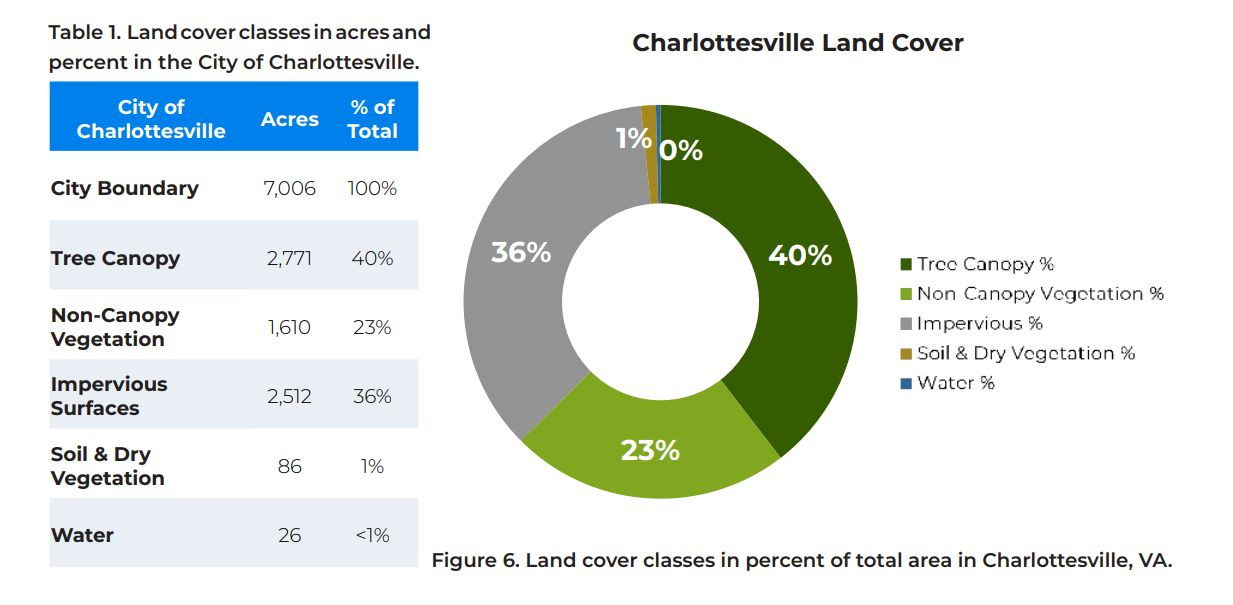
Commissioner Philip d’Oronzio said the Housing Advisory Committee met several times in the past month. The group includes d’Oronzio and the leaders of several nonprofit housing organizations.
“All of those meetings focused heavily on exactly what you’d expect which would be zoning, anti-displacement and the like,” d’Oronzio said. “We’ve produced some work product that’s been shoved toward the Planning Commission and some interim stuff that we are working on.”
More on that as we get to that section of the meeting.
There was no report from the University of Virginia’s representative on the Charlottesville Planning Commission.
“I think everything that I mentioned last month is still operable,” said Bill Palmer, the GIS Planner for the UVA Office of the Architect. “Nothing new to report.”
The UVA Board of Visitors has met once since the Planning Commission’s last regular meeting. Here’s an update on what I was able to write about in the past six weeks or so.
UVA has picked two groups to move forward with affordable housing projects, August 25, 2023
UVA panel signs off on design for video scoreboard, September 18, 2023
Nau is new chair of UVA’s land use committee, September 20, 2023
Buildings and Grounds Committee review designs for biotech institute, energy plant, and garage at Fontaine Research Park, September 23, 2023
Renovations and additions coming to UVA Center for Politics, September 29, 2023
Commissioner Rory Stolzenberg is the new Planning Commission representative on the Land Use and Environmental and Planning Committee. That’s a closed-door body that consists of city, Albemarle County and UVA officials.
The charter for LUEPC was changed on July 21 to further make clear it is not a public body unlike the Planning and Coordination Council that it replaced in late 2019 The minutes state these are the reasons for LUEPC’s existence:
“Allow professional staff to collaborate and develop solutions on a continuous basis with regularly scheduled reports to leadership of all three entities”
“Retain visibility into the substance of the work via publicly posted agendas, notes, and materials.”
According to the July 21, 2023 minutes, they were to have met on August 18. However, the LUEPC website does not list a meeting from that date or from September.
10-12.
Second shout-out: Design Develop
In today’s second Patreon-fueled shout-out, architectural firm Design Develop wants you to know about a new service aimed at the development community that may not be widely known yet — 3D point cloud scanning! That’s a technique that uses specialized equipment, such as 3D scanner systems, to gather a large amount of data points that represent the surface of the scanned object or scene.
The applications of 3D point cloud scanning are extensive and cover various fields, including architecture, construction, cultural heritage preservation, virtual reality, industrial design, manufacturing, and more. These applications require accurate 3D spatial information, and Design Develop’s workflow provides precise and comprehensive results, all while being more cost-effective than traditional methods.
Design Develop has expertise in this workflow for their own needs and now has a dedicated team offering this service in the Charlottesville and Albemarle Area. If you're involved in the real estate, design, or construction industry, feel free to contact us for more information or a free quote.
Visit their website for an introductory video that captures the 3D point cloud scanning of the Downtown Transit Center and a booklet that will explain more!
Planning Commission learns of plan to treat Preston Avenue differently in new zoning code
After spending several hours on two rezonings under the city’s existing development rules, the Charlottesville Planning Commission spent 80 minutes on continued deliberations about what they would recommend to City Council. Would they make a recommendation?
Their discussion was aided by a set of materials that was not included in the original meeting packet for the meeting and was uploaded to the city’s calendar under the “Other” tab for the meeting. The 36 page document begins with a draft resolution for approval followed by a list of changes to the zoning code suggested by Commissioners during their previous deliberations. (read the materials)
There are also several specific map changes that had previously been discussed plus at least one that had not.
For the first time, Commissioners saw language for a new “Core Neighborhoods Corridor Overlay District” created at their direction. These would allow for additional height through a special exception process but only if certain conditions are met.
“These racially diverse and affordable neighborhoods historically met their day to day needs on the adjacent Preston and Cherry Avenue corridors,” reads the statement of intent for this section. “The Core Neighborhoods Corridor Overlay District is intended to support these neighborhoods and implement the Comprehensive Plan goals of encouraging the construction and continued existence of moderately priced housing, creating and preserving affordable housing, respecting the cultural heritage of the adjacent neighborhoods, supporting public health, encouraging economic development activities that provide desirable employment, and the overall promotion of a convenient and harmonious community.”
Commissioners first went through a series of recommendations for changes to the zoning code for Council to consider. Each one is numbered. Here are some highlights but you’ll also need a link to the current draft to make any sense of it. (view the current draft for reference)
Building heights:
The maximum height for a building in Residential-A would be increased to 35 feet if there is one unit. The height could be as tall as 40 feet if there’s more than one unit. Previously there was no additional height for additional units. Freas said this would allow for people who want flat roofs. (#3)
The base height for a building in Residential-C would be increased to 40 feet, up from 35 feet. The allowed height would increase to 52 feet if there were affordable units on site. (#9)
The bonus height for affordability in Node Mixed Use 8 would be increased from 142 feet to 156 feet. (#11)
The bonus height for affordability in Corridor Mixed Use 8 would be increased from 142 feet to 156 feet. (#12)
The bonus height for affordability for Node Mixed Use 10 would be increased from 170 feet to 184 feet. (#13)
The bonus height for affordability for Downtown Mixed Use would be increased to 184 feet. Previously those limits would be up to the Board of Architectural Review. (#14)
The bonus height for affordability in Industrial Flex 8 would be increased to 156 feet. (#15)
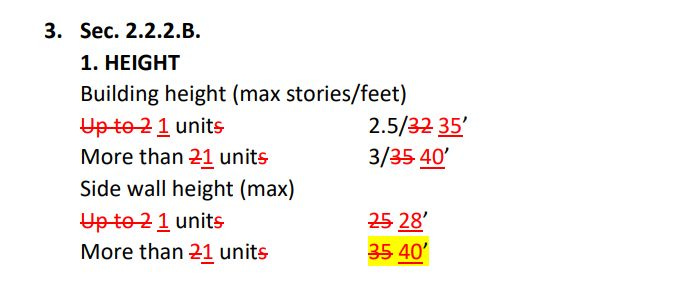
Uses:
At least one residential unit would be required to enable commercial uses in residential zones. However this could be waived by a special use permit.
Commercial uses allowed in Residential-B and Residential-C would be allowed by-right on corner lots. (#32)
There is a whole new section regulating homestays, a big change from the original final draft which had phased them out. Now there’s a whole set of rules that were not there before. (#34)
There was a discussion about item #49 which deals with transitions. The group Charlottesville Area Developers Roundtable (CADRE) asked for this language to be inserted: “Transitions are not required along street lot lines where the RoW between the abutting zoning designations is greater than 29 feet.” Commissioner Carl Schwarz pointed out that this could allow buildings higher than three stories on West Street. The Commission agreed to not insert this language.
There’s a whole new section for a Special Exception Permit that was not previously in the draft. More on that in a moment. (page 21)

Late night deliberations
The suggested changes came from many sources. Commissioner Rory Stolzenberg sought to insert language for a church he said wanted to expand.
“It’s in CX-3 or something and it’s next to R-B and you can do a church that is the same height and setback or whatever in R-B but because it’s CX-3, it requires a transition,” Stolzenberg said. “They’re being punished for being in that higher zone whereas if they were in R-B, they would be able to do it more flexibly.”
Stolzenberg got suggested language from CODE Studio and the rest of the Commission agreed to make the change.
Map changes:
Fifth Street Extended including the Willoughby Shopping Center would be increased from Corridor Mixed Use 5 to Corridor Mixed Use 8. This had been previously discussed.
The section of U.S. 29 from the U.S. 250 bypass to Greenbrier Road (almost) would be increased from Node Mixed Use 8 to Node Mixed Used 10. This had been previously discussed.
Commissioners saw a new map for the Venable neighborhood that would increase areas close to the University of Virginia from Residential Mixed Use 3 to Residential Mixed Use 5. Commissioners discussed whether to make a portion of Grady Avenue that still remained RX-3 to also be RX-5, but ended up keeping it as is.
Land owned by the University of Virginia Foundation on 10th and Wertland that has been designated for UVA’s affordable housing initiative had been proposed as Civic but will now be rezoned to Corridor Mixed Use 8. (most recent story)
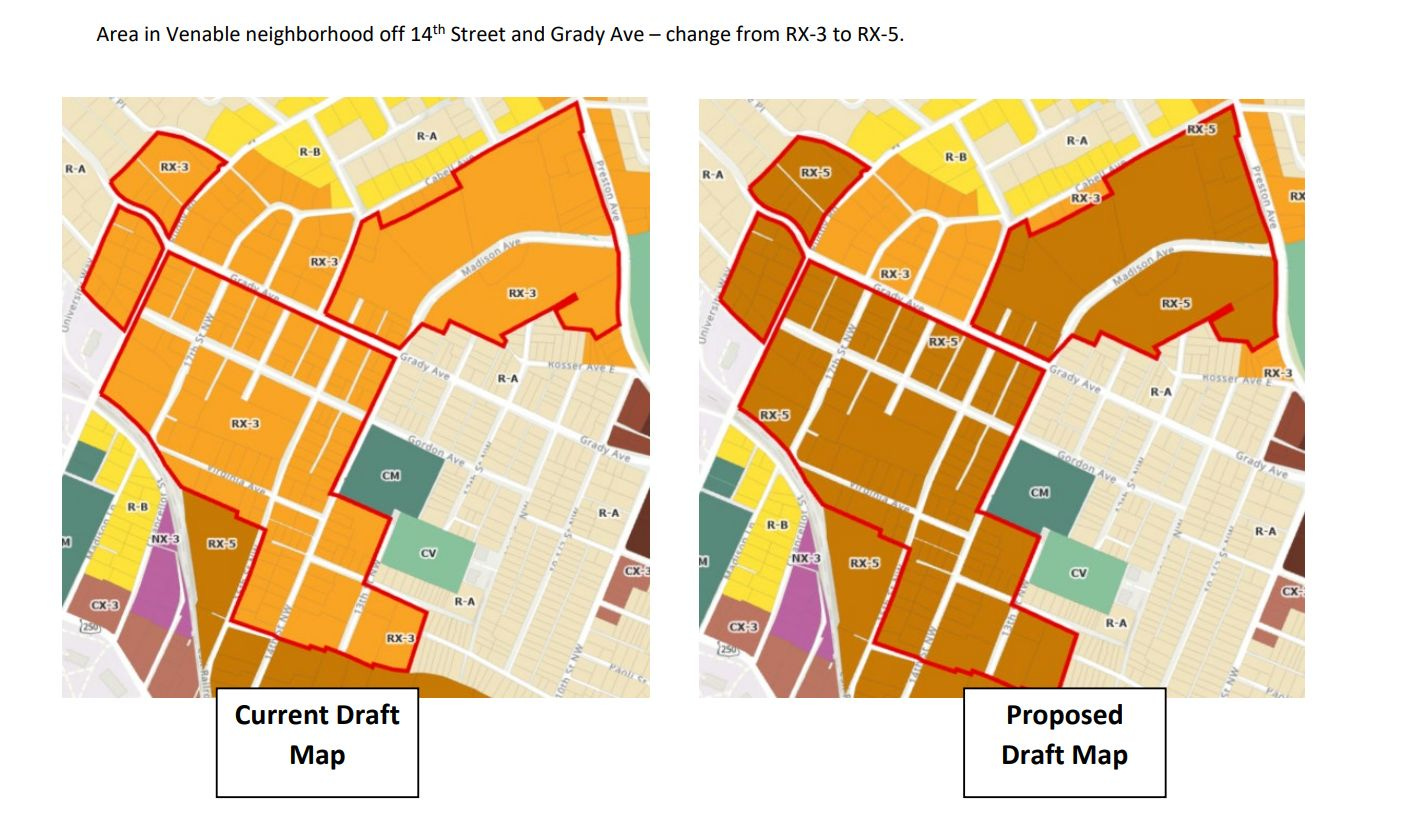
One map change that had not yet been seen or discussed regarded the Core Neighborhood Overlay District. All of Preston Avenue between Rosser and McIntire would be reduced to Corridor Mixed Use 3, including the site that had been proposed for Dairy Market Phase Three.
“We’re proposing taking Preston Avenue and Cherry Avenue and Cherry Avenue was already CX-3 but making the length of Preston Avenue also CX-3 and then applying this overlay district which would basically say you have to get a special exception permit in order to get additional height.”
To get that height, a developer would need to provide at least two items from a list.
A quarter of the units must be affordable at 60 percent of the area median income
“Affordably priced commercial” space must be made available for neighborhood focused uses
Space would be provided for educational training, job training, or other similar uses
Provide dedicated indoor space or outdoor space for use by the local community
Space for a community garden or urban agriculture
Sustainable design features
Local art installations
“Other features or amenities that support the intent of this section and the goals of the Comprehensive Plan.”
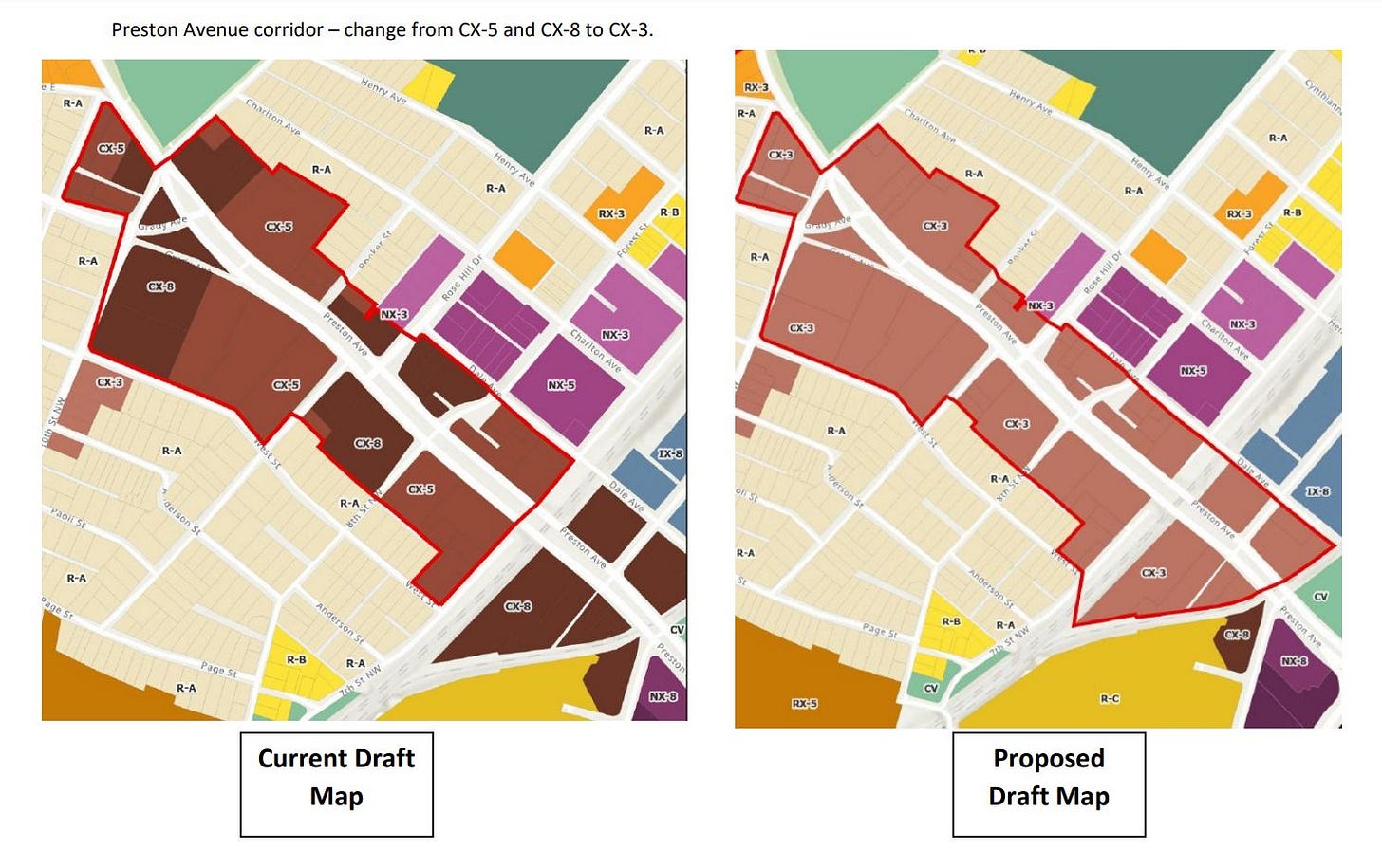
Such special exceptions would have to be approved by City Council. A developer could still get additional height if they provided affordable units, though.
“I think we’ve really set this up as an either/or,” Freas said.
Commissioner Lyle Solla-Yates had extensive notes about the idea and wanted more work done in anticipation of potential legal challenges.
“Specific, measurable things that we can fight in court,” Solla-Yates said.
For instance, he argued that each of the amenity spaces to be provided have a minimum of 2,500 square feet. He said the local art must be done in participation with a “local art authority.” Other Commissioners weren’t so keen on the last one.
Commissioner Rory Stolzenberg said he would like provision of units guaranteed for households lower than 60 percent of AMI.
“I would assume that the idea is to push people to incorporate some [Low-Income Housing Tax Credit] element or PHA element for the project,” Stolzenberg said, not defining PHA.
Commissioners reached consensus to reduce the amount of affordable units needed from 25 percent to 20 percent. We’ll come back to this point later in this segment.
What could the Commission vote on?
One of the major points of the entire Cville Plans Together initiative is to encourage and guarantee subsidized units where affordability hasn’t always been preserved. How will success be measured? What will the rules be? Many will be codified and explained in the Affordable Dwelling Unit Manual rather than in the code itself. (view the ADU manual)
Still, some high-level rules will be in the body of the zoning ordinance itself. Commissioner Phil d’Oronzio said suggested change #38 for the “Term of Affordability” section.
Affordable units created for sale must be sold to households with incomes less than 60 percent of the area median income. The language reviewed would require a deed restriction giving “the City of Charlottesville or a qualifying non-profit organization a right of first refusal to purchase the home upon its first resale.” (#38)
A question that sprang from this moment was a discussion of whether the Planning Commission has to make a recommendation on the Affordable Dwelling Unit Manual itself as well as the Development Review Procedures manual.
Sharon Pandak, the city’s outside counsel, said yes but that vote did not have to happen at the October 10 session.
“They don’t have to be in this particular resolution tonight but I do think it would be useful for them to make recommendations to Council,” Pandak said.
Another district?
d’Oronzio asked if the Planning Commission should make a recommendation on an idea for a new district that he brought to Freas. At least one Commissioner thought he meant the new Core Neighborhoods Corridor Overlay District.
“That’s tonight,” Stolzenberg said.
“No, yet another one,” d’Oronzio said.
“The neighborhood overlay district,” Freas said.
Freas cleared up the matter.
“I met with Commissioner d’Oronzio in his capacity representing the Housing Advisory Committee today and we talked about a new district… that basically mirrors the [Residential-A] district that we’ve proposed but tamps it down for these anti-displacement areas.”
Freas said this would mimic the original intent of the Sensitive Communities Areas that were proposed in the Comprehensive Plan that would restrict development rights in certain areas. Only one additional housing unit would be allowed if affordability provisions were not being sought.
“And then it will allow up to six units if all of the bonus units were affordable,” Freas said.
However, the language was not ready for this meeting and Freas wanted to know if the Planning Commission could make a recommendation based on the concept if not the details.
Pandak asked if she had been sent this second idea of a new district and Freas said no.
“It was a conversation today at lunch time and what we’re trying to address are the comments raised by Council at the last meeting,” Freas said.
That meeting was the October 3 meeting by City Council where they discussed anti displacement efforts. I’ve not had a chance to write about that one yet. Pandak weighed in.
“I think you could approve recommendations tonight with respect to the zoning ordinance and the map… and then you could say in addition, the Planning Commission makes the following recommendation conceptually about the district,” Pandak said.
Pandak said the language would have to be reviewed to see whether the details of this second district would need to formally go through the Planning Commission.
‘We need to flesh out some of the concepts of this,” Pandak said. “Simply saying ‘we have also this new district’ in my mind is not sufficient to do anything more than take it up later.”
“Just a reminder, we’re discussing material that none of us have reviewed or considered,” said Planning Commissioner Lyle Solla-Yates.
“Because it doesn’t exist yet beyond a conversation that was had,” Freas said.
“I’m just saying that conceptually I would have difficulty saying let’s move forward with this with a pending district and or overlay which might be a significant portion of this,” d’Oronzio said.
Commissioners discussed whether to wait another week to flesh out the concept further, or to send it along to Council as just the concept. d’Oronzio said he was opposed to doing so without fleshing out the details first before the Planning Commission signed off on the next steps.
“I want a whole code and not a code full of holes, and it seems to me that we’re leaving a fairly substantial hole of a very, very important matter that has not gotten frankly the bandwidth that it needs to get,” d’Oronzio said.
With about twenty minutes to go in the meeting, Freas said he felt there were too many items that needed to be locked down before the Planning Commission took up a recommendation.
“Based on the level of discussion that we’re at, I’m kind of inclined to say that we need to go ahead and capture all of this and bring it back to a subsequent meeting,” Freas said.
A final meeting to take a vote will be held on October 18. That will give time for d’Oronzio’s idea to be further developed for review.
There was a brief discussion of this late Tuesday including establishing what the boundaries for this area would be. Other changes may also be made between now and it being published in another Planning Commission agenda.
Commissioner Habbab said he was concerned about this approach and repeated what he had previously said when this idea didn’t make it into the zoning.
“It gives me the same heartache that I had before about essentially downzoning sensitive communities,” Habbab said. “It’s a negative on their generational wealth-building.”
“Yes, but what this is informed by in part is that there is no debate in the anti-displacement about the preference,” d’Oronzio said. “The preference is way over on the side of ‘preserve my neighborhood’ over the wealth issue.”
Commissioner Schwarz was also concerned and this will likely lead to a further discussion on October 18. The Commission did not make a recommendation and technically continued the meeting rather than an adjournment. Sharon Pandak insisted on that language.
To wrap-up this segment, one quick property transaction from this month. On October 6, a couple purchased 905 Page Street for $600,000. The lot and a previous structure sold for $30,000 in September 2017 to Loft Realty and Investments LLC. Another entity called Viator LLC bought the lot in February 2019 for $80,000 and built a structure. This sold for $435,000 in January 2020 and $577,000 in June 2022.
Could it be that some know how to make money, and the rest of us just live here? At least, for now?
Next up in my coverage, I’ll write up City Council’s anti-displacement conversation from October 3. I also hope to write up the City Council’s discussion on population from October 11.
So much to write. Stay tuned.
Reading material:
Albemarle School Board at-large race pushing early voting participation, Felicity Taylor, CBS19, October 9, 2023
500-unit development proposed in Hollymead, Jason Armesto, Charlottesville Daily Progress (paywall) October 10, 2023 (story broken by me in the October 4 edition)
Build up: The total number of places to live is growing, but who’s counting?, Sean Tubbs, C-Ville Weekly, October 11, 2023
The Epilogue of #588
Want to know when the next edition is coming out? If you’ve not seen one for a day or two, check out my Notes on Substack to see if I’ve opted to take some time off or if I’m working on something else. There’s where you’ll see an announcement of my decision from yesterday to wait until today to publish what you’ve just read. The city is about to make a tremendous change that will affect everyone who lives here, and the details matter.
You’re reading this because you tend to agree. I’m grateful for the hundreds of subscribers who have helped to get me to this point and I’m grateful for those who have yet to do so. I’m in the early stages of setting up an internship to get some assistance and to help train people to do this kind of work. I think up-close journalism that covers the municipal beat is crucial to democracy. If no one’s watching, who knows what might happen?
Special thanks to Ting for their unique sponsorship. They will match the initial payment whether it be $5 a month, $50 a year, or $200 a year.
In addition to this unique sponsorship, Ting sponsors Scott Stadium, the Ting Pavilion, and the John Paul Jones Arena. Maybe you’re in the market for a new high speed internet provider? If so, check out Ting! If you sign up for Ting at this link and enter the promo code COMMUNITY, you’ll get:
Free installation
A second month for free
A $75 gift card to the Downtown Mall
.















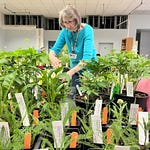
Share this post